Maximizing Efficiency with No-Code Automation Platforms: The Future of AI Productivity Tools
In today’s fast-paced digital landscape, businesses and individuals alike are continually seeking ways to enhance productivity and streamline operations. One of the most significant advancements in this pursuit is the rise of AI productivity tools, particularly no-code automation platforms. These platforms empower users to automate repetitive tasks without the need for extensive programming knowledge, enabling a smoother workflow and increased efficiency.
Understanding No-Code Automation Platforms
No-code automation platforms are intuitive software solutions that allow users to create automations through graphical user interfaces rather than traditional coding. They democratize technology by enabling non-technical users to build workflows that enhance business processes. Here are some key benefits of utilizing these platforms:
- User-Friendly Interfaces: Simplifies the automation process with drag-and-drop features.
- Rapid Deployment: Speeds up the time taken to implement workflows.
- Cost-Effective: Reduces the need for hiring specialized developers for automation tasks.
- Scalability: Easily adapts to increasing business requirements.
Popular No-Code Platforms
There are several notable no-code automation platforms available today, each catering to different business needs:
- Zapier: Connects apps and automates workflows seamlessly.
- Integromat: Provides advanced scenarios and data manipulations.
- Airtable: Combines the simplicity of a spreadsheet with powerful database features.
- Bubble: Allows for building fully functional applications without coding.
Integrating AI with No-Code Automation
The merging of AI capabilities with no-code automation platforms significantly enhances their utility. By leveraging AI, these platforms can analyze data, predict outcomes, and optimize workflows based on user behaviors.
Use Cases for AI in No-Code Automation
Here are a few scenarios where AI integration proves beneficial:
- Customer Support: Automating responses and ticketing systems using AI chatbots.
- Lead Generation: Using AI to qualify leads and automate follow-up sequences.
- Data Analysis: AI tools that automatically sort and analyze data for actionable insights.
Challenges and Considerations
While no-code automation platforms offer remarkable versatility and ease of use, there are challenges to consider:
- Limited Customization: Some platforms may not offer the flexibility needed for specific use cases.
- Integration Issues: Potential difficulties in syncing with existing systems.
- Security Concerns: Handling sensitive data requires robust security measures.
Best Practices for Implementation
To successfully implement no-code automation in your workflow, consider the following best practices:
- Identify repetitive tasks that can be automated.
- Start with small projects to understand the platform’s capabilities.
- Regularly review and optimize existing automations.
- Train team members to utilize the no-code tools effectively.
The Future of Work with No-Code Automation Platforms
As businesses increasingly adopt no-code automation platforms, the future of work appears brighter. Organizations can expect increased productivity, reduced operational costs, and enhanced agility in responding to market changes. The emergence of AI further amplifies these advantages, creating an ecosystem where innovation and adaptability thrive.
Conclusion
No-code automation platforms are revolutionizing the way we approach productivity and workflow management. By removing the barriers typically associated with programming, they empower users to take control of their processes. As AI continues to evolve and integrate with these platforms, the potential for increased efficiency and effectiveness becomes virtually limitless. Embrace these tools to transform your productivity landscape today.
The Rise of No-Code Automation Platforms
As businesses evolve, the demand for faster and more efficient workflows continues to grow. No-code automation platforms have emerged as a revolutionary tool enabling users to streamline their operations without needing extensive programming knowledge. These platforms empower users to create, automate, and optimize processes effortlessly. For teams that may lack dedicated IT resources, these user-friendly solutions provide a much-needed hand in enhancing productivity and maintaining competitiveness.
Benefits of Implementing No-Code Automation
The advantages of integrating no-code automation platforms into your workflow are plentiful. First and foremost, they significantly reduce the time spent on repetitive tasks, enabling employees to focus on more strategic activities that drive business value. With the empowerment to automate processes—from simple data entry to complex multi-step workflows—companies can achieve higher efficiency levels.
Moreover, these platforms facilitate better collaboration among teams. By automating communication between different software applications, employees can share data and insights in real-time, thereby improving decision-making. As a result, no-code automation platforms not only enhance productivity but also foster a culture of innovation and continuous improvement.
Getting Started with No-Code Automation
Embarking on the journey to implement no-code automation platforms begins with identifying pain points and repetitive tasks within your organization. Conducting a process audit can help highlight areas where automation would yield significant time savings and efficiency gains. Once you’ve pinpointed these areas, engage team members in the selection process for the right platform that aligns with your organization’s needs.
Most no-code automation platforms offer an intuitive interface and a variety of pre-designed templates to kickstart your automation journey. Training sessions or workshops can also help team members become comfortable with the tool, ensuring a smooth transition and optimized use across the organization.
Future Trends in No-Code Automation
As technology continues to advance, the future of no-code automation platforms looks promising. One emerging trend is the integration of artificial intelligence, which will further enhance automation capabilities by enabling smarter decision-making processes. With AI-driven insights, businesses can anticipate needs and respond swiftly, putting them ahead of the competition.
Another trend to watch is the expansion of no-code platforms beyond traditional business functions. As more industries recognize the power of automation, we can expect to see these tools applied in creative fields, healthcare, and even education, transforming how organizations operate across sectors.


